by Lisa Cooke | Aug 19, 2017 | 01 What's New, DNA |
When it comes to chocolate my general rule of thumb is that more is usually better! The same is true with DNA testing. With this big DNA test upgrade sale, now is the perfect time to get MORE! I love being Your DNA Guide here at Genealogy Gems, and today I’ll walk you through how to get the best deal and the right tests. Take my hand, and let’s get upgrading!

 This month, Family Tree DNA is running this Family Tree DNA’s Friends & Family sale, which means that all of the kits and upgrades are on sale! This sale is the perfect time to upgrade your DNA tests. (By clicking our link above you are supporting the free Genealogy Gems Podcast. It doesn’t cost you anything extra, and we will receive compensation from the affiliate link. Thank you!)
This month, Family Tree DNA is running this Family Tree DNA’s Friends & Family sale, which means that all of the kits and upgrades are on sale! This sale is the perfect time to upgrade your DNA tests. (By clicking our link above you are supporting the free Genealogy Gems Podcast. It doesn’t cost you anything extra, and we will receive compensation from the affiliate link. Thank you!)
Once in your account, click the Upgrade button. In very basic terms, to Upgrade means that they are going to go back to your DNA sample that they have on file, and do more testing.

Depending on the tests you have already had completed at Family Tree DNA, you will see several different options in the Upgrade menu. Most of you will see this box, listing the option to do more advanced testing, find gene variants, or order certificates.

If you’re testing for general genealogy purposes, you can most likely ignore all of those options. The advanced testing is aptly named as it is only for very specific, very, advanced problems. The gene variant report can be interesting, but you can get a similar report for only $5 from Promethease.com. As for the certificates, that is up to you. It is a printed report of your DNA values for either your YDNA or your mtDNA test. These are nice to give to relatives that have tested for you that might want something tangible to hold as evidence of their participation in your genetic genealogy efforts.
The last option in this box is to have a personalized report written. This will be several pages of information about the DNA testing you have had completed, but don’t expect them to find your ancestors or do much interpretation of the results.
Beyond those options, if you have not had mitochondrial DNA testing completed, or if you have only had the lower mtDNAPlus test completed, you will see options to evaluate your mtDNA. If you are going to try to do family history with your mtDNA test, you need to have the Full Sequence test completed. For the most part, using mtDNA in your family history won’t get you very far, but it is a good record of your direct maternal line.
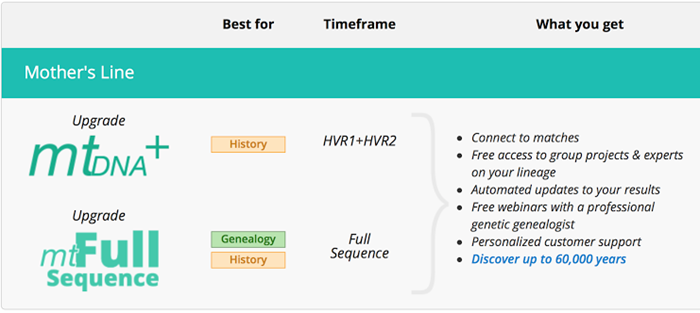
If you are a man with the YDNA test, you will also see options to upgrade your YDNA test to a higher number of markers. You will want to upgrade from 37 to 67 or 111 if you have other matches on your match page who have also tested at those higher levels and you would like to get a better comparison. You can check to see if they have tested at a higher level by looking at your match page under their name. In general, the 67 marker test will help you better decide if you are or are not related to someone, while the 111 marker test will help you better determine how you are related to known connections on your match list.
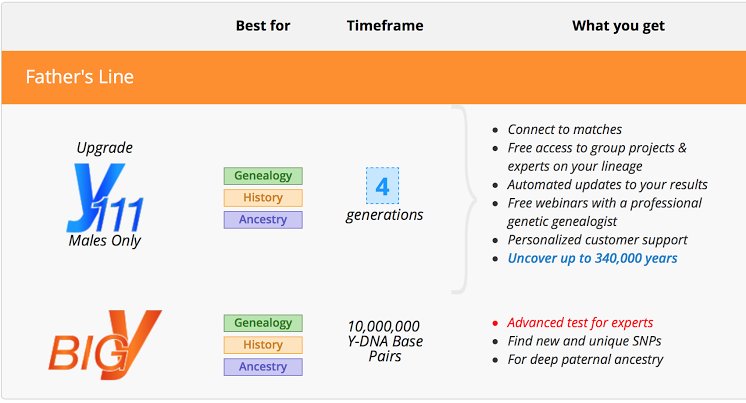
If you have not yet taken the Family Finder test at Family Tree DNA, that option will present itself as well. If the person tested is still available for testing, you should actually start their autosomal DNA testing experience with AncestryDNA, then transfer for free into their FTDNA account. If your family member is deceased, then you can get permission from their closest living relative, or whoever is administrating their account, to have them tested on the Family Finder test at Family Tree DNA.
So remember my general rule of thumb when it comes to chocolate and DNA testing, more is usually better. Click here to shop the Family Tree DNA Friends & Family!
Get more help with my quick guide: Understanding Family Tree DNA.
by Lisa Cooke | Feb 20, 2017 | 01 What's New, DNA, Kids |
DNA testing for kids is a great way to spark their interest in their heritage, while teaching science, math, geography, and more. Consider these reasons and start with the budget-friendly option of an autosomal test.
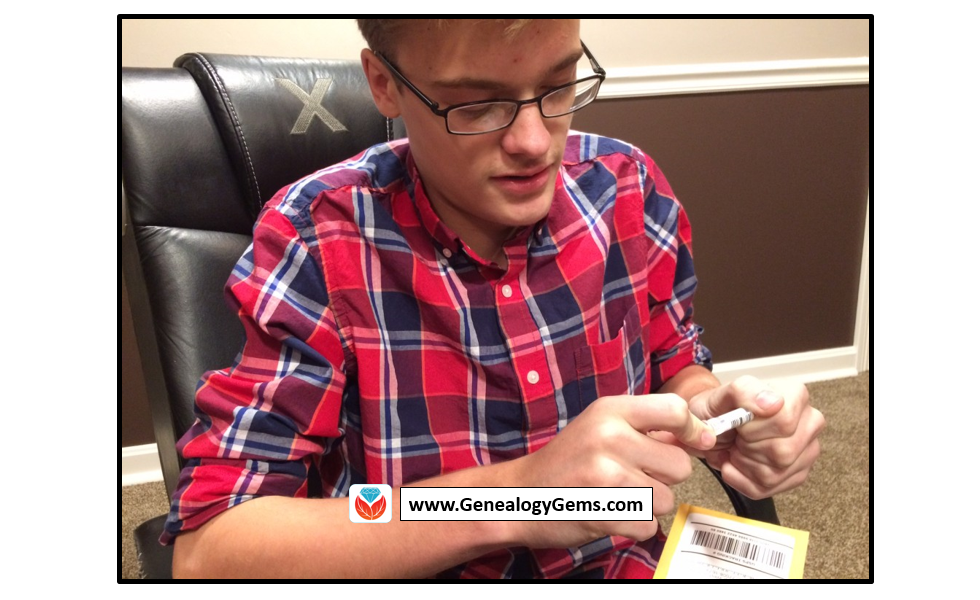
According to a 2010 study out of Emory University, if we want to encourage kids toward an activity that will positively impact them, we should steer them toward family history. The researchers reported, “Children who know stories about relatives who came before them show higher levels of emotional well-being.”
Now, I know I don’t need to convince you of this. You are already sold on genealogy. But let’s explore how DNA testing might be able to help you share your love of family history with your children and grandchildren.
Why Try DNA Testing for Kids
Since you know this is me, the genetic genealogist talking, you can probably guess what I’ll suggest for getting kids interested in family history. DNA testing is a great way to personally and physically involve them. There is the tangible process of taking the sample at home, and the marvel at how such a simple act can produce the amazing display of our ethnicity results. Since each of us is unique, it will be fun for them to compare with you and other relatives to see who-got-what-from-who. This will naturally lead to questions about which ancestor provided that bit of Italian or Irish, and wham! You’ll be right there to tell them about how their 5th great-grandfather crossed the ocean with only the clothes on his back, determined to make a new start in a new land.

If there are parts of the ethnicity report you can’t explain, use that as a hook to encourage them to start digging and to find out why you have that smattering of eastern European or Southeast Asian. Taking them for a tour of the DNA match page, you can show them how they share 50% of their DNA with their sister (whether they like it or not!) and how they share 25% with their grandparent!
DNA test results give kids a totally unique look at their personal identity with technology that is cutting edge. Looking at their DNA test results can turn into a math lesson, a science lesson, a geography lesson, a lesson on heredity or biology, or a discussion on identity. DNA is the perfect introduction to the wonders that genealogy can hold, especially for children.
A Warning and Caution
As with all DNA testing pursuits, this one should not be taken lightly, even with all of its benefits.
An important word to parents: Be sure to keep unintentional consequences in the forefront of your mind. This includes the possibility of revealing family secrets. Talk with your spouse and make sure you are both on the same page. In the end, this is your decision.
An important word to grandparents and other relatives: DNA testing is a parent’s decision. Even though you’re passionate about preserving the family’s history and the benefits of including children are numerous, you must obtain parental consent if you are not the parent.
More About Autosomal DNA Testing for Kids
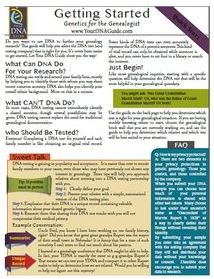 Click here to learn more about my series of how-to videos (available to Gems fans for a special price) or start your kids’ or grandkids’ DNA journey with two of my genetic genealogy quick guides. The first is a great overview and the second talks about autosomal testing which is a good test for genetic genealogy beginners.
Click here to learn more about my series of how-to videos (available to Gems fans for a special price) or start your kids’ or grandkids’ DNA journey with two of my genetic genealogy quick guides. The first is a great overview and the second talks about autosomal testing which is a good test for genetic genealogy beginners.
by Lisa Cooke | Oct 17, 2016 | 01 What's New, Blogs, Listeners & Readers, Writing Family History |
Creating and maintaining a genealogy blog is a fun and rewarding way to share your family history. Blogging is also effective in finding cousin connections! If you are worried your blog isn’t pulling in the cousins you expected, elevate your ranking in search results by implementing these 3 ways to improve your genealogy blog.

I recently received this exciting email from Ruth:
“Thank you, thank you, thank you! Several months ago, I attended one of your all-day seminars in Bossier City, Louisiana and I must thank you for motivating me!
I’ve been researching my family tree off and on for 25 years or so, and at times it has taken a back burner to whatever was going on in my life; only to be dusted off when I would get an inquiry or perhaps when someone in the family passed away. In the last 3 years, I have been attending these local seminars with a distant cousin. They were fun and I learned a few things, but none had generated the enthusiasm that I have at the moment!
The knowledge that you share and the easy manner in which you deliver your presentations are so down-to-earth and it inspires me to learn more. I left your seminar with a Premium Membership package and I have been listening to your podcast ever since.
You also encourage your readers to blog about their genealogy. I took your advice and I’ve done just that. Please take a look at my blog – any suggestions you might have would be welcomed. The title is My Family Tree: Hobby or Addiction? and I have dedicated it to my father who passed away in 2005! Here is the link: http://myfamilytreehobbyoraddiction.blogspot.com/
Thank you again for all you do that encourages us and for the new tools that you share with your listeners to help their journey along the way!
Many thanks,
Ruth Craig Estess”
Ruth, thank you and congratulations!

I love hearing how you have put it into action what you learned at the seminar.
Tips for Improving Your Genealogy Blog
Ruth is doing a terrific job including family information on her genealogy blog that others might be Googling. That means they are very likely to find her. But there’s more that can be done. Here are 3 additional tips for Ruth and anyone who wants to get more traction with their genealogy blog:
“1. Add more images. Google looks postively upon websites that have images. It considers the website to be more of an authority on the subject covered in the blog. Images improve Search Engine Optimization (SEO.) In layman’s terms, SEO refers the ways in which you have made your blog easy to use, and easy for Google to understand what it is about. The better Google understands the subject, the better chance it has of delivering your blog as a result when people search on things you write about (like your family tree!) It’s important that your image files have names that accurately reflect what they and your blog post are about. Therefore, it’s a solid strategy to include relevant genealogical information such as names, places and dates in the image titles. If you don’t happen to personally have photos about the subject of your blog post, include images of documents or other related items.
2. Include a Call to Action. At the end of each post, invite your readers to comment and contact you if they are researching the same family. It’s amazing what a little invitation will do to prompt interaction. If you skip this step, your readers may just “lurk”, or in other words, quietly read and then go on to the next website. That’s a missed opportunity for connection and collaboration. Even though a reader may be researching the family you are writing about, they may not think to reach out to you or comment unless you prompt them to do so.
3. Make use of blog categories. Categories and Labels help organize you blog content. Create a category for each surname you discuss on your blog. The category can appear in the side column on your blog. That makes it easy for readers to click a surname they are interested in and jump directly to your posts that discuss that name.”
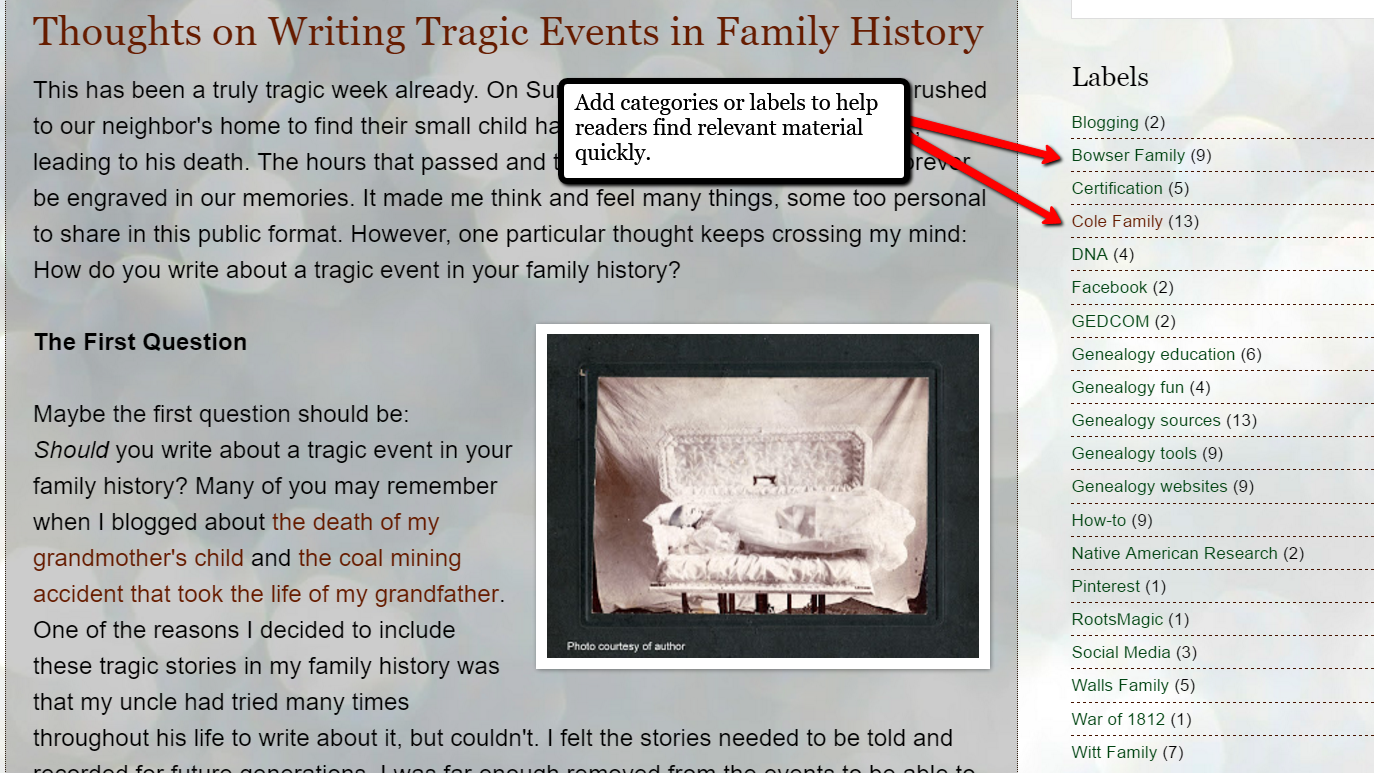
Categories and Labels are great for SEO too. Google loves well-organized websites because they are easier to understand and deliver in search results.
More Gems on Creating Your Own Genealogy Blog
Ruth wrote to tell me she has already started putting these ideas into practice. She’s on her way to rising in the search results and hearing from distant cousins. How exciting! Click below to continue reading about rewarding and effective family history blogging.
Why Marketing Experts Would Agree That You Should Write a Family History Blog
Why and How to Start a Family History Blog
Genealogy Blogging, the Future of Genealogy and More
Tell Us About Your Genealogy Blog
Do you have a genealogy blog? Well, here’s my call to action! Please share your family history blog, SEO tips, and success stories in the comments area below.
And I would so appreciate it if you would share Genealogy Gems with your friends and blog readers by including a link to our website in your list of favorite genealogy help sites on your blog. Thanks!

 This month, Family Tree DNA is running this Family Tree DNA’s Friends & Family sale, which means that all of the kits and upgrades are on sale! This sale is the perfect time to upgrade your DNA tests. (By clicking our link above you are supporting the free Genealogy Gems Podcast. It doesn’t cost you anything extra, and we will receive compensation from the affiliate link. Thank you!)
This month, Family Tree DNA is running this Family Tree DNA’s Friends & Family sale, which means that all of the kits and upgrades are on sale! This sale is the perfect time to upgrade your DNA tests. (By clicking our link above you are supporting the free Genealogy Gems Podcast. It doesn’t cost you anything extra, and we will receive compensation from the affiliate link. Thank you!)









